The celebration of the New Year in Rus' has the same complex fate as its history itself. First of all, all changes in the celebration of the new year were associated with the most important historical events that affected the entire state and each person individually. Undoubtedly folk tradition even after the officially introduced changes in the calendar, it retained ancient customs for a long time. For residents Russian cities New Year is the main holiday of winter and is celebrated on January 1st. However, there are exceptions among city residents who do not celebrate the New Year. A real holiday for a believer is the Nativity of Christ. And before it is the strict Nativity Fast, which lasts 40 days. It begins on November 28 and ends only on January 6, in the evening, with the rising of the first star. There are even villages where all residents do not celebrate the New Year or celebrate it on January 13 (January 1, Julian style), after Lent and Christmas.
Now let's return to the history of New Year celebrations in Rus'
Celebrating the New Year in pagan Rus'.
 How the New Year was celebrated in pagan ancient Rus' - one of the unresolved and controversial issues in historical science. No affirmative answer was found at what time the year began.
How the New Year was celebrated in pagan ancient Rus' - one of the unresolved and controversial issues in historical science. No affirmative answer was found at what time the year began.
The beginning of the New Year celebration should be sought in ancient times. Thus, among ancient peoples, the New Year usually coincided with the beginning of the revival of nature and was mainly confined to the month of March.
In Rus' there was a proleta for a long time, i.e. the first three months, and the summer month began in March. In honor of him, they celebrated Ausen, Ovsen or Tusen, which later moved to the new year. Summer itself in ancient times consisted of the current three spring and three summer months - the last six months consisted winter time. The transition from autumn to winter was blurred like the transition from summer to autumn. Presumably, originally in Rus' the New Year was celebrated on the day of the vernal equinox March 22. Maslenitsa and New Year were celebrated on the same day. Winter has been driven away, which means a new year has arrived.
Celebrating the New Year after the Baptism of Rus'
![]() Together with Christianity in Rus' (988 - Baptism of Rus'), a new chronology appeared - from the creation of the world, as well as a new European calendar - the Julian, with a fixed name for the months. The beginning of the new year began to be considered March 1.
Together with Christianity in Rus' (988 - Baptism of Rus'), a new chronology appeared - from the creation of the world, as well as a new European calendar - the Julian, with a fixed name for the months. The beginning of the new year began to be considered March 1.
According to one version, at the end of the 15th century, and according to another in 1348, the Orthodox Church moved the beginning of the year to September 1, which corresponded to the definitions of the Council of Nicaea. The transfer must be placed in connection with the growing importance of the Christian Church in state life ancient Rus'. The strengthening of Orthodoxy in medieval Rus', the establishment of Christianity as a religious ideology, naturally causes the use of “holy scripture” as a source of reform introduced into the existing calendar.
The reform of the calendar system was carried out in Rus' without taking into account the working life of the people, without establishing a connection with agricultural work. The September New Year was approved by the church, following the word of the Holy Scriptures; Having established and substantiated it with a biblical legend, the Russian Orthodox Church has preserved this New Year's date until modern times as an ecclesiastical parallel to the civil New Year. In the Old Testament church, the month of September was celebrated annually, to commemorate peace from all worldly worries.
Thus, the New Year began on the first of September. This day became the feast of Simeon the First Stylite, which is still celebrated by our church and known among the common people under the name Semyon of the Summer Conductor, because on this day summer ended and the new year began. It was a solemn day of celebration for us, and the subject of analysis of urgent conditions, collection of quitrents, taxes and personal courts.
Innovations of Peter I in the celebration of the New Year
 In 1699, Peter I issued a decree according to which January 1 was considered the beginning of the year. This was done following the example of all Christian peoples who lived not according to the Julian, but according to the Gregorian calendar. Peter I could not completely transfer Rus' to the new Gregorian calendar, since the church lived according to the Julian calendar. However, the Tsar in Russia changed the calendar. If earlier years were counted from the creation of the world, now the chronology began from the Nativity of Christ. In a personal decree he declared: “Today the year of the Nativity of Christ is one thousand six hundred and ninety-nine, and from next January on the 1st day the new year 1700 will begin, together with a new century of centuries.”
It should be noted that the new chronology existed for a long time together with the old one - in the decree of 1699 it was allowed to write two dates in documents - from the Creation of the world and from the Nativity of Christ.
In 1699, Peter I issued a decree according to which January 1 was considered the beginning of the year. This was done following the example of all Christian peoples who lived not according to the Julian, but according to the Gregorian calendar. Peter I could not completely transfer Rus' to the new Gregorian calendar, since the church lived according to the Julian calendar. However, the Tsar in Russia changed the calendar. If earlier years were counted from the creation of the world, now the chronology began from the Nativity of Christ. In a personal decree he declared: “Today the year of the Nativity of Christ is one thousand six hundred and ninety-nine, and from next January on the 1st day the new year 1700 will begin, together with a new century of centuries.”
It should be noted that the new chronology existed for a long time together with the old one - in the decree of 1699 it was allowed to write two dates in documents - from the Creation of the world and from the Nativity of Christ.
The implementation of this reform of the Great King, which had such important, began with the fact that it was forbidden to celebrate in any way on September 1, and on December 15, 1699, the beating of drums announced something important to the people who poured into Red Square in crowds. A high platform was built here, on which the royal clerk loudly read the decree that Peter Vasilyevich commands " From now on, the summers will be counted in orders and in all matters and fortresses written from January 1 from the Nativity of Christ.”
The king steadily ensured that New Year's celebration was no worse and no poorer here than in others European countries Oh.
Peter's decree wrote: "...On large and well-traveled streets, for noble people and at houses of deliberate spiritual and worldly rank, make some decorations in front of the gates from trees and branches of pine and juniper... and for poor people, each place at least a tree or branch on the gate or above their temple ...". The decree did not talk specifically about the Christmas tree, but about trees in general. At first they were decorated with nuts, sweets, fruits and even vegetables, and they began to decorate the Christmas tree much later, from the middle of the last century.
The first day of the New Year 1700 began with a parade on Red Square in Moscow. And in the evening the sky lit up with the bright lights of festive fireworks. It was from January 1, 1700 that folk New Year's fun and merriment gained recognition, and the celebration of the New Year began to have a secular (not church) character. As a sign of the national holiday, cannons were fired, and in the evening, multi-colored fireworks, never seen before, flashed in the dark sky. People had fun, sang, danced, congratulated each other and gave New Year's gifts.
New Year under Soviet rule. Change of calendar.
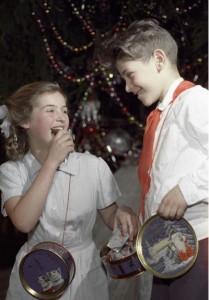 After the October Revolution of 1917, the country's government raised the question of calendar reform, since most European countries had long switched to the Gregorian calendar, adopted by Pope Gregory XIII back in 1582, and Russia still lived according to the Julian calendar.
After the October Revolution of 1917, the country's government raised the question of calendar reform, since most European countries had long switched to the Gregorian calendar, adopted by Pope Gregory XIII back in 1582, and Russia still lived according to the Julian calendar.
On January 24, 1918, the Council of People's Commissars adopted " Decree on the introduction of the Western European calendar in the Russian Republic." Signed V.I. Lenin published the document the next day and came into force on February 1, 1918. It said, in particular: “...The first day after January 31 of this year should be considered not February 1, but February 14, the second day should be considered the 15th, etc.” Thus, Russian Christmas shifted from December 25 to January 7, and the New Year holiday also shifted.
Contradictions immediately arose with Orthodox holidays, because, having changed the dates of civil holidays, the government did not touch church holidays, and Christians continued to live according to the Julian calendar. Now Christmas was celebrated not before, but after the New Year. But this did not bother the new government at all. On the contrary, it was beneficial to destroy the foundations of Christian culture. The new government introduced its own, new, socialist holidays.
In 1929, Christmas was cancelled. With it, the Christmas tree, which was called “ priestly» custom. New Year was cancelled. However, at the end of 1935, an article by Pavel Petrovich Postyshev appeared in the Pravda newspaper and “Let’s organize a good Christmas tree for the children for the New Year!”. Society, which had not yet forgotten the beautiful and bright holiday, reacted quite quickly - Christmas trees and Christmas tree decorations appeared on sale. Pioneers and Komsomol members took upon themselves the organization and holding of New Year trees in schools, orphanages and clubs. On December 31, 1935, the Christmas tree re-entered the homes of our compatriots and became a holiday." have a joyful and happy childhood in our country," a wonderful New Year's holiday that continues to delight us today.
old New Year
 I would like to return once again to the change of calendars and explain the phenomenon of the Old New Year in our country.
I would like to return once again to the change of calendars and explain the phenomenon of the Old New Year in our country.
The very name of this holiday indicates its connection with the old style of the calendar, according to which Russia lived until 1918, and switched to a new style by decree of V.I. Lenin. The so-called Old Style is a calendar introduced by the Roman Emperor Julius Caesar (Julian calendar). The new style is a reform of the Julian calendar, undertaken on the initiative of Pope Gregory XIII (Gregorian, or new style). From an astronomical point of view, the Julian calendar was not accurate and allowed for errors that accumulated over the years, resulting in serious deviations of the calendar from the true movement of the Sun. Therefore, the Gregorian reform was necessary to some extent.
The difference between the old and new styles in the 20th century was already plus 13 days! Accordingly, the day that was January 1 in the old style became January 14 in the new calendar. And the modern night from January 13 to 14 in pre-revolutionary times was New Year's Eve. Thus, by celebrating the Old New Year, we are, as it were, joining history and making a tribute to time.
New Year in the Orthodox Church
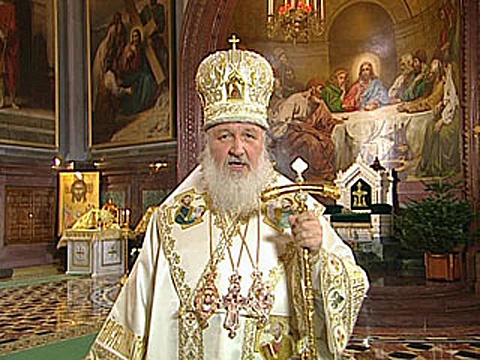 Surprisingly, the Orthodox Church lives according to the Julian calendar.
Surprisingly, the Orthodox Church lives according to the Julian calendar.
In 1923, on the initiative of the Patriarch of Constantinople, a meeting of the Orthodox Churches was held, at which a decision was made to correct the Julian calendar. Due to historical circumstances, the Russian Orthodox Church was unable to take part in it.
Having learned about the meeting in Constantinople, Patriarch Tikhon nevertheless issued a decree on the transition to the “New Julian” calendar. But this caused protests and unrest among the church people. Therefore, the resolution was canceled less than a month later.
The Russian Orthodox Church states that at present it does not face the question of changing the calendar style to Gregorian t. “The vast majority of believers are committed to preserving the existing calendar. The Julian calendar is dear to our church people and is one of the cultural features of our life,” - said the Secretary for Inter-Orthodox Relations of the Department for External Church Relations of the Moscow Patriarchate, Archpriest Nikolai Balashov.
Did you know that Knowledge Day was previously considered a completely different holiday? In the 15th century in Rus', it was on this day that they celebrated... New Year! Why did the custom develop to celebrate the New Year on September 1? The history of the holiday on September 1 is confusing and very interesting.
The date of the holiday was postponed more than once - even earlier, according to pagan canons, the beginning of the year was celebrated on March 1. However, in 988, Christianity was adopted in Rus', and with it came the Byzantine calendar. According to new religious trends, the New Year was supposed to be celebrated in the fall, on September 1, but long-standing traditions were not so easy to cancel. Therefore, the Russian people continued to celebrate the year with the awakening of nature in the spring. Why was New Year celebrated on September 1? It’s logical - the harvest has been harvested, all the work has been completed, and so the new year begins.
Why used to celebrate the New Year on March 1 and September 1? All because of the same Russian devotion to tradition. In 1492, Tsar Ivan III issued a decree according to which the New Year was officially moved to autumn. However, despite the official celebrations, people continued to celebrate twice. It is noteworthy that many of the spring celebration traditions have remained to this day, but the rituals were timed to coincide with the spring Maslenitsa.
Even later, Peter I, who was so eager to bring Rus' to European standards, established the celebration of the New Year on January 1, as was customary in Western European countries. It was then that the chronology from the Nativity of Christ was adopted.
It is noteworthy that not everyone who asks the question “why was the New Year celebrated on September 1” knows that even now the Russian Orthodox Church celebrates the so-called “New Year” according to the old style - September 1.
By the way, the usual paraphernalia in the form of a Christmas tree, gifts and toys had nothing to do with the New Year initially. But after the revolution, they tried in every possible way to crowd out religious holidays from the consciousness of Russians, so all the traditions inherent in Christmas were transferred to the New Year.
Although it was only under the Soviet Union that the Day of Knowledge began to be officially celebrated on September 1, the history of the holiday of students began precisely under Peter I.
Since until the end of the 17th century the church celebrated the beginning of the year on September 1, and most schools were located at churches, education began on this date.
And after the New Year was moved to January 1 in 1699, a misunderstanding occurred - according to the new holiday dates, 1699 lasted only 4 months from September to January. But studies went on as usual, and you can’t force students to pore over books for more than a year without a break! Besides, autumn vacation would bring children much less benefit and pleasure. Therefore, the tradition of celebrating the beginning of the school year in September was left unchanged.
By the way, despite the fact that the holiday is considered international, in many countries Knowledge Day is celebrated at a completely different time. For example, Japan rings out the first bell in April, and school ends in March. In the USA there is no clear date at all - each district determines it itself. Therefore, in different parts of the country, schoolchildren go to study in different time. On average, this date ranges from July to September.
Australia starts school in February, while in Germany schoolchildren start school in mid-October.
By the way, in Russia, the issue of a flexible schedule for students has often been raised - for example, in the north of the country, students have long been sent on vacation during the polar night.
Turns out, New Year's celebration- the most ancient of all existing holidays. During excavations of ancient Egyptian pyramids, archaeologists found a vessel on which was written: “The beginning of the new year.” In Ancient Egypt, the New Year was celebrated during the flood of the Nile River (around the end of September). The Nile flood was very important because... Only thanks to him did grain grow in the dry desert. On New Year's Day, statues of the god Amun, his wife and son were placed in a boat. The boat sailed along the Nile for a month, which was accompanied by singing, dancing and fun. The statues were then brought back into the temple.
And the ancient Romans, even before our era, began to give New Year's gifts and have fun all New Year's Eve, wishing each other happiness, good luck, and prosperity.
For a long time, the Romans celebrated the New Year in early March, until Julius Caesar introduced a new calendar (now called the Julian). Thus, the first day of January became the date of the New Year. The month of January was named after the Roman god Janus (two-faced). One face of Janus was supposedly turned back to the past year, the other - forward to the new one. The New Year's holiday was called "Kalends". During the holiday, people decorated their houses and gave each other gifts and coins with the image of the two-faced Janus; slaves and their owners ate and were merry together. The Romans gave gifts to the emperor. At first this happened voluntarily, but over time the emperors began to demand gifts for the New Year.
They say that Julius Caesar gave one of his slaves freedom on New Year's Eve because he wished him to live longer in the new year than in the old one.
On the first day of the New Year, the Roman Emperor Caligula went out to the square in front of the palace and accepted gifts from his subjects, writing down who gave, how much and what...
In Ancient Babylon, the New Year was celebrated in the spring. During the holiday, the king left the city for several days. While he was away, the people were having fun and could do whatever they wanted. A few days later, the king and his retinue, dressed in festive clothes, solemnly returned to the city, and the people returned to work. So every year people started life anew.
The Celts, the inhabitants of Gaul (the territory of modern France and part of England) celebrated the New Year at the end of October. The holiday was called Samhain from “summer's end” (end of summer). On the New Year, the Celts decorated their homes with mistletoe to drive out ghosts. They believed that it was on the New Year that the spirits of the dead came to the living. The Celts inherited many Roman traditions, including the requirement New Year's gifts from subjects. Jewelry and gold were usually given. Centuries later, thanks to this tradition, Queen Elizabeth I amassed a huge collection of embroidered and bejeweled gloves. On New Year's Day, husbands gave their wives money for pins and other trinkets. This tradition was forgotten by 1800, but the term "pin money" is still used and refers to money for small expenses.
The New Year in medieval England began in March. Parliament's decision to move the New Year to January 1, 1752 encountered female opposition. A delegation of indignant Englishwomen told the speaker that Parliament does not have the right to make women many days older, to which the speaker allegedly replied: “This is a classic example of female logic!”
In ancient times, the New Year was most often associated with spring - the beginning of the rebirth of nature and the expectation of a new harvest. Therefore, in Rus', the New Year was celebrated on March 1. In the 14th century, the Moscow Church Council decided to consider September 1 as the beginning of the New Year according to the Greek calendar. And only in 1699, Peter I, returning from a trip to Europe, with a special decree, ordered that “from now on summers should be counted” from January 1: “Since in Russia they count the New Year differently, from now on stop fooling people and count the New Year everywhere from the first of January. And as a sign of good beginnings and fun, congratulate each other on the New Year, wishing prosperity in business and in the family. In honor of the New Year, make decorations from fir trees, amuse children, and ride down the mountains on sleds. But adults shouldn’t indulge in drunkenness and massacres – there are enough other days for that.”
The girls, when cleaning on December 31, carefully swept under the table; if they came across a grain of grain, it meant marriage; and so that there would be new things all year, on January 1 they put on all their best and changed clothes several times throughout the day. On January 2, the peasants performed a ritual to protect the house.
Many of us wonder how to celebrate the New Year? Despite the fact that the holiday is considered a home holiday, thousands and thousands of Russians will leave the country New Year holidays and scatter around the world - in all directions, hoping to get more impressions and celebrate the New Year as brightly as possible.
Today we will not consider options and offer our own scenarios, it’s still early, the New Year is far away and we will definitely offer holiday scenarios and original ideas for gifts. And today let’s take a closer look at the history and traditions of the holiday.
How the New Year was celebrated in Rus'
New Year's traditions have developed over the centuries, so today, while thinking about how to celebrate the New Year, we can remember the history of the holiday and borrow ideas that were present at the holiday from our ancestors.
In Ancient Rus', the celebration of the New Year was divided into two periods - holy evenings and terrible evenings. Evenings before the first of January were considered holy, after the first of January - terrible. Our ancestors believed that during the first days of the New Year, evil spirits acquired special power, created atrocities, and harmed everyone. In order to somehow protect themselves from evil forces, a sign in the form of a cross was placed above the doors and windows. Therefore, the New Year evoked not so much joy as trepidation. “Holidays are all terrible,” the peasants said. On such evenings, they were afraid not only to go on a visit, but to stick their nose out of the hut.
Then our ancestors apparently got tired of celebrating the New Year in winter. They began to celebrate it on March 1st. True, many expressed dissatisfaction and tried to celebrate the winter New Year in parallel with the spring New Year - in January, because the more holidays, the more fun life is! Only the March New Year did not last long. Soon the start of the year was moved to September 1st. According to one version, this is due to the decision of the Orthodox Church, because September is a very important month for believers. So we decided that there was no better time of year to celebrate the holiday.
It was only in the 18th century that the New Year was moved to January 1st. Tsar Peter I, by his decrees, ordered the introduction of chronology from the Nativity of Christ, and the year from January 1. He ordered to celebrate the New Year with a solemn prayer service, ringing bells, roaring shots and fireworks, “...to amuse children, and not to commit massacres.” It was especially stipulated that everyone should congratulate each other on the holiday and give gifts - until that time, gifts were not a mandatory attribute of the New Year.
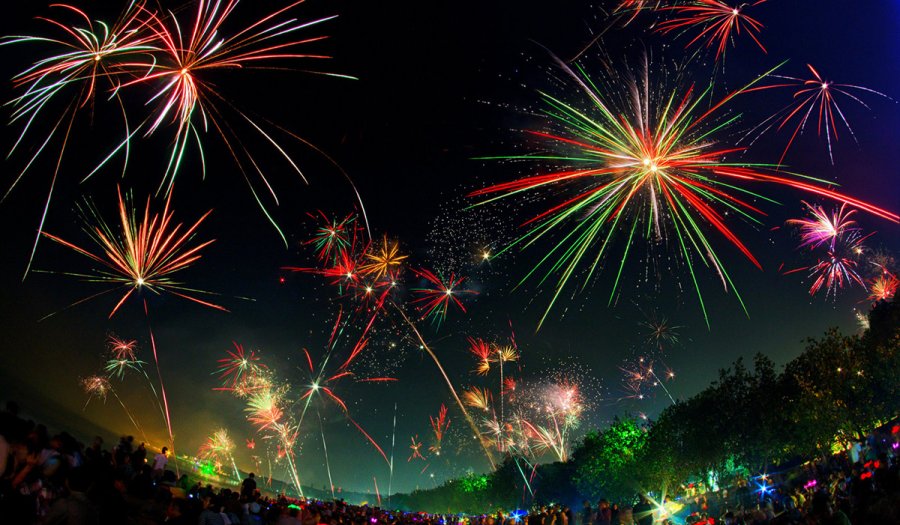
The people and boyars did not argue with the Tsar over the celebration of the New Year.
People began to prepare more diligently for this holiday, decorating their houses with green branches. And most importantly, they began to give each other New Year's gifts. By the way, when Peter I celebrated the New Year with his courtiers, he did not forget about the people - he displayed various dishes and vats of beer and wine in front of the palace.
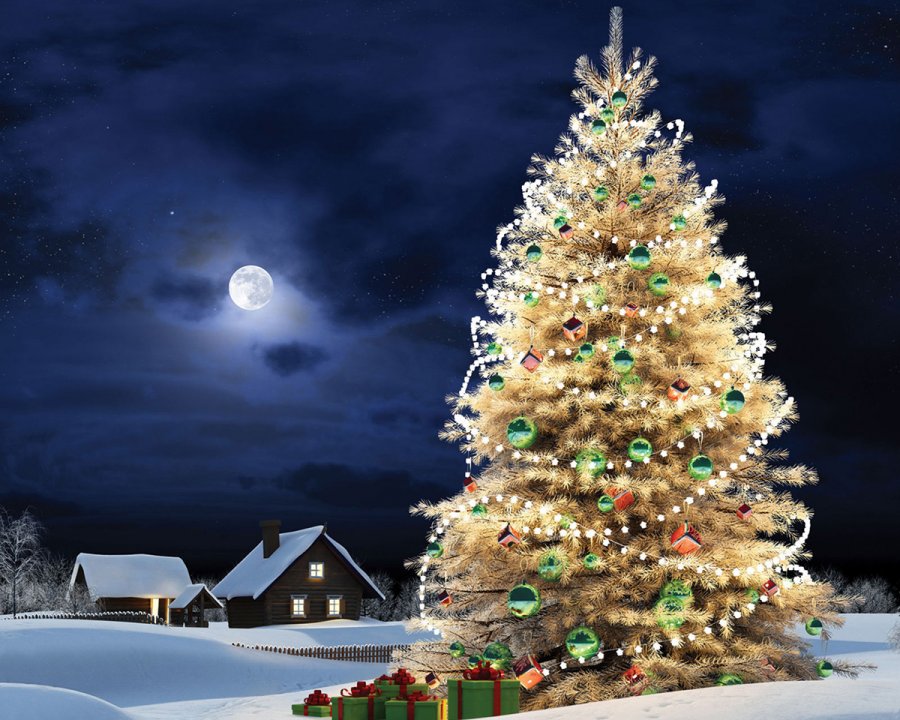
The holiday tree was primarily a child's play. Having chosen a strong, beautiful spruce, they hung it with children’s toys and danced around the tree. It was even allowed to climb the tree in order to get the desired toys and sweets. After the celebration ended, the remaining toys were removed from the tree and distributed to the children.
Later, the decoration of the Christmas tree became more sophisticated, and certain rules for decorating the Christmas tree appeared. The top is crowned with the “Star of Bethlehem”. The balls (formerly apples) represent the forbidden fruit that our ancestors Adam and Eve ate. All kinds of curly gingerbread cookies and cookies, which replaced the waffles obligatory during the Middle Ages, are reminiscent of the unleavened bread used during the communion ceremony. Over time, everything became simpler; colorful toys, lanterns, and baskets began to be hung on spruce branches. And then came the fashion for toys made of papier-mâché, porcelain, embossed cardboard, glass beads and glued beads, transparent and frosted glass.
It is not surprising that children immediately fell in love with the holiday. Simultaneously with children's joy in toys and sweets, adults also delighted each other - they made various gifts, and along the way made small presents for servants, governesses and the poor. Therefore, many were looking forward to celebrating the New Year, because this holiday became the most fun and joyful for everyone, from the smallest to the gray-haired elders.
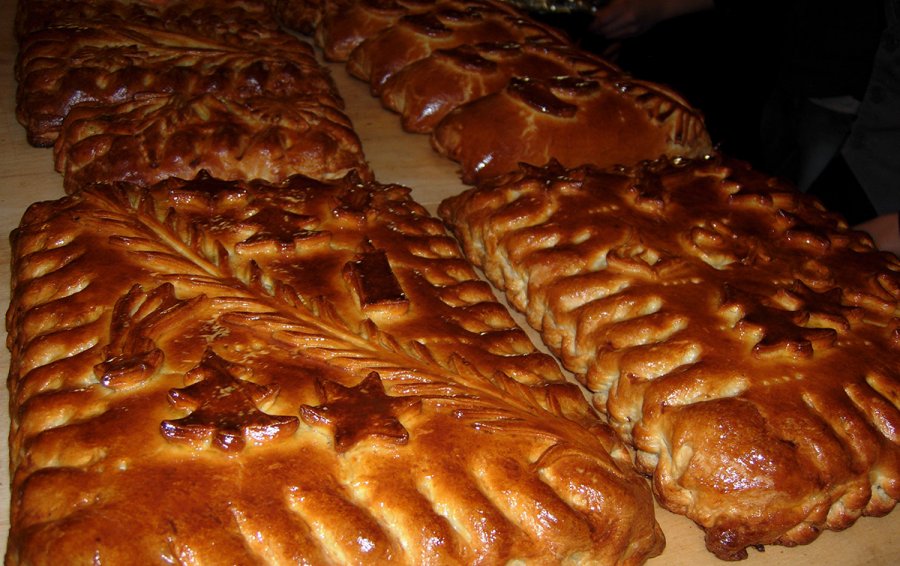
New Year's table
Pie was considered the pinnacle of the festive festivities, a long-awaited delicacy. This is an echo of the fact that bread was the main dish and the source of all life.
Before New Year's dinner, seeds of rye, wheat, and oats were sprinkled on the table. Then the table was covered with a clean tablecloth.
Another important New Year's dish for Russians, Ukrainians and Belarusians was sweet porridge-kutya and pancakes. Porridge was cooked from whole grains and several types of cereals. It was believed that there would be a hearty meal for the New Year, which meant that the house would have a full bowl all year.
In addition, figurines of domestic animals - goats, cows, calves, horses - were sculpted and baked from dough. Then, when people came to the house to carol, the guests were presented with these figurines and other sweets.
Some customs and beliefs
Usually, before the New Year, they tried to repay all debts, forgive all insults, those who were in a quarrel were obliged to make peace, so they asked each other for forgiveness.
People tried to enter the New Year in everything new, for which purpose they put on a new dress and new shoes on the holiday. People believed that this would contribute to increased prosperity.
The first day of the New Year was also important. Attention was paid to how the day would go. After all, the whole coming year depended on it.

Did you know that Knowledge Day was previously considered a completely different holiday? In the 15th century in Rus', it was on this day that they celebrated... New Year! Why did the custom develop to celebrate the New Year on September 1? The history of the holiday on September 1 is confusing and very interesting.
The date of the holiday was postponed more than once - even earlier, according to pagan canons, the beginning of the year was celebrated on March 1. However, in 988, Christianity was adopted in Rus', and with it came the Byzantine calendar. According to new religious trends, the New Year was supposed to be celebrated in the fall, on September 1, but long-standing traditions were not so easy to cancel. Therefore, the Russian people continued to celebrate the year with the awakening of nature in the spring. Why was New Year celebrated on September 1? It’s logical - the harvest has been harvested, all the work has been completed, and so the new year begins.
Why used to celebrate the New Year on March 1 and September 1? All because of the same Russian devotion to tradition. In 1492, Tsar Ivan III issued a decree according to which the New Year was officially moved to autumn. However, despite the official celebrations, people continued to celebrate twice. It is noteworthy that many of the spring celebration traditions have remained to this day, but the rituals were timed to coincide with the spring Maslenitsa.
Even later, Peter I, who was so eager to bring Rus' to European standards, established the celebration of the New Year on January 1, as was customary in Western European countries. It was then that the chronology from the Nativity of Christ was adopted.
It is noteworthy that not everyone who asks the question “why was the New Year celebrated on September 1” knows that even now the Russian Orthodox Church celebrates the so-called “New Year” according to the old style - September 1.
By the way, the usual paraphernalia in the form of a Christmas tree, gifts and toys had nothing to do with the New Year initially. But after the revolution, they tried in every possible way to crowd out religious holidays from the consciousness of Russians, so all the traditions inherent in Christmas were transferred to the New Year.
Although it was only under the Soviet Union that the Day of Knowledge began to be officially celebrated on September 1, the history of the holiday of students began precisely under Peter I.
Since until the end of the 17th century the church celebrated the beginning of the year on September 1, and most schools were located at churches, education began on this date.
And after the New Year was moved to January 1 in 1699, a misunderstanding occurred - according to the new holiday dates, 1699 lasted only 4 months from September to January. But school went on as usual, and it’s impossible to force students to pore over books for more than a year without a break! In addition, the autumn holidays would bring much less benefit and pleasure to children. Therefore, the tradition of celebrating the beginning of the school year in September was left unchanged.
By the way, despite the fact that the holiday is considered international, in many countries Knowledge Day is celebrated at a completely different time. For example, Japan rings out the first bell in April, and school ends in March. In the USA there is no clear date at all - each district determines it itself. Therefore, in different parts of the country, schoolchildren go to school at different times. On average, this date ranges from July to September.
Australia starts school in February, while in Germany schoolchildren start school in mid-October.
By the way, in Russia, the issue of a flexible schedule for students has often been raised - for example, in the north of the country, students have long been sent on vacation during the polar night.




